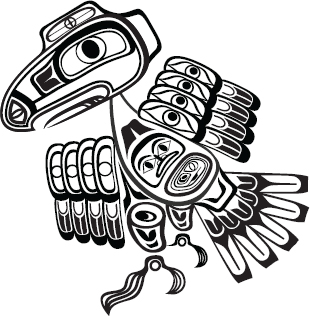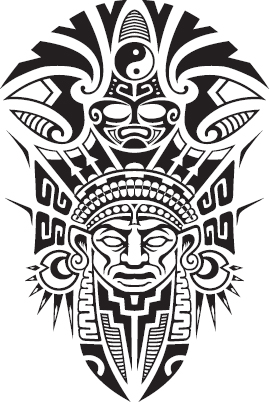
Long ago, our ancestors held all creation sacred. They understood that we are part of nature, that nature is part of us, and that we have an intimate relationship with the animals and plants with which we share the earth. Our ancestors drew no distinction between the natural and the supernatural, and the same holds for many indigenous cultures today. Reverence for the natural world is evident in most global traditions. Animals are beautifully and vividly portrayed in ancient cave paintings and petroglyphs all over the world, most famously in Lascaux and Chauvet, France. Sometimes people are portrayed as part animal; for example, a man with antlers. Many origin or creation myths tell of a time when the boundary between human and animal was thin, when an animal could become a human or a human could turn into an animal.
North American Indian creation stories describe animals and plants as the “First People.” The First People jointly agreed to help humankind, whom they saw as weak and helpless beings, by sacrificing their lives to allow the humans to live. As part of this exchange, humans were endowed with the ability to communicate with the spirits of the plants and animals. According to these traditions, this capability brought Humans into the Order of Life.
It is believed that animal sounds are the origins of language, and many cultures have traditions that relate how animals taught us the skills we need for living. There are many tales of humans watching and learning from animal behavior. One of these tales explains that American Indians call the wolf “brother,” since it was the wolf who taught them how to hunt. Native Americans understood that animals have wisdom to impart and can teach us; so to Native Americans, animals had status.
All over the world, ancient societies passed down legends, songs, and stories that prove the strong link that connects animals, gods or spirits, and humans. An inspiration to us all, they tell of a time when the spirits of animals communicated with humans, or the spirits or gods communicated with humans through animals. From Europe to Siberia, North America to China, this is part of a tradition that began during a magical time when humans were at peace with animals and when they understood each other's language.
Some ancient traditions named their tribes or clans after animals, birds, or fishes. The American Indians of the Pacific Northwest, for example, have a complex clan arrangement based on totem animals, represented by powerful woodcarvings, which closely associate them with the animals' symbolic power. Different traditions might have a tribal totem, another totem for the clan, and yet another for the family into which a person is born.
The Aborigines of Australia and the Bushmen of Africa have similar traditions of totems or power animals. Some Australian Aborigine clans believe that the extinction of a species brings us a step closer to human extinction. The ancient Egyptians had some gods that were part animal, part human being. Ancient priests and priestesses might wear an animal skin to link them to the god and to the essence of the animal and to allow them to take on the quality or power related to the animal.
In ancient Greece, Aesop's fables for the most part portrayed animals, and their abundance of wisdom and foolishness. These stories have given rise to sayings still used today, such as, “cunning as a fox” and “wise as an owl.” In ancient Rome, the augur studied nature and learned to read signs by observing the movement and behavior of birds and later of animals. Worldwide, fairy tales are full of animals speaking and acting powerfully.
Like the American Indians and Australian Aborigines, the early inhabitants of Britain revered the natural world, viewing rivers, forests, hills, and trees as the dwelling places of spirits. Ancient Irish, Welsh, and Scottish texts often tell of how the father of a hero is a god who shape-shifts into an animal or bird, who then visits a woman. The newborn child is then usually linked with an animal. Celtic clan names were connected to animals, and Celtic art is magnificently intertwined with animals and birds.
The Druids of the British Isles and northern Europe also had animal guides, and many are the tales of magicians having animals as familiars. Merlin is said to have taken a wolf as a companion when he retired. The British goddess Brighid is often depicted as a wolf, one of the guardians of Britain.
A pagan inheritance from pre-Christian times has carried over into early indigenous British Christianity (previously known as Celtic Christianity) as a kind of nature mysticism. When monasteries were built over Druidic natural sacred sites, such as springs and groves, they were given the names of Christian saints and Christian rituals, but, reflecting a deep reverence for the land, believers celebrated God's creation, the natural world. Worship was often conducted outside under the heavens, in wooded areas or by a river. Brighid was Christianized as Saint Brigit, but was still depicted with a wolf by her side. Animals and birds were treated the same as human beings—with care, hospitality, and respect. Combining a sense of spirituality with love for nature and all its creatures, people frequently told stories about saints who worshipped in wild and remote places and who had animals and birds as companions. Saint Columba of Iona honored a crane as a pilgrim guest. Saint Cuthbert of Lindisfarne communed with seals and sea otters, and spoke with birds.

Norse sagas tell of shape-shifting and familiars, while Norse and medieval heraldry picked up on the tradition of totem animals. Animals, birds, and plants were painted onto shields, banners, and headgear, tattooed onto people's skin, and carved onto settlement entrances. More than mere pictures, the totem animals acted as guardian spirits.
The Lions Club, a worldwide volunteer organization, provides a contemporary example of how a totem animal might be unconsciously adopted. Sports teams in the United States often have animals as mascots. Christianity uses the fish and the lamb as symbols. Perhaps a child cuddles a teddy bear for comfort and believes that it helps, unwittingly but instinctively calling on the spirit of a totem animal.
Anyone who has read or seen the world-famous Harry Potter stories will not have missed the owl that acts as the young wizard's messenger. Although the concept is not fully explored in the stories, it appears that the owl somehow watches over the hero. Tradition tells us that the owl is associated with the teaching of magic, a perfect fit for a young wizard. Perhaps the reported surge in interest in having an owl as a pet that followed the success of the Harry Potter novels was because a number of people were taken by the idea of having that particular kind of familiar.
In the movie The Golden Compass, released globally in December 2007 and based on Northern Lights (the first book in Philip Pullman's His Dark Materials trilogy), each character in that alternate world has a helpful bird or animal daimon. This creature appears to be part of the person's soul, yet it expires when the person is killed, and the outcome for both when the daimon and the person are separated is tragic. Fascinatingly, in this version of the totem animal, the form of the daimon is flexible and changing throughout childhood and becomes fixed into one form only during adolescence.
The expression “a little bird told me” is still used today, although perhaps most often by older people. Implicit in this saying is that the information came in some secret or magical way that cannot be explained.
Sensing that chasing after “the new” is causing a split between themselves and nature, more and more people are being drawn to the “old ways.” The oldest-known form of spiritual practice is shamanism. Most ancient societies throughout the world were originally shamanic and believed in animal allies and helpers; in other words, they believed that spiritual guides used totem animals to direct and empower human beings. Each community, tribe, or clan had its own shamanic way, learned through practice and experience. In modern societies, shamans are usually chosen for some notable quality and then trained, or becomes one because of some powerful event, such as a near-death experience. Also known among American Indians as medicine men (or women), shamans work with the otherworld to guide and assist people, as well as deepen their own knowledge and inner power.
Shamans believe there is spirit in all things. Working with ritual items made of clay, stone, or pieces of wood, or with skin, hide, feathers, or claws, in ritual or dance, shamans call on their totem animals. This is not an act of worship but an acknowledgment of the totem animals' power. With their help and protection, shamans can journey through their totems' elements—air if the totem is Eagle, for example, or water if the totem is Salmon—as well as in the otherworld. Shamans can call on the totem animals' help to empower their spiritual work for themselves and for their communities. Before a hunt, for example, contact is made with the spirit of the prey animal to explain the need for the animal's flesh and to give thanks for the creature's sacrifice. Shamans can call on their totem animals to access assistance from other spirit guides and indeed might have any number of totem animals to help them in their work.

Shamans can take on their totem animals' natural attributes, so the keen sight of Eagle would be reflected in clear vision, which might be physical but which is essentially spiritual. Taking on the guise of the creature by wearing skins or other animal or bird parts during a ritual or dance, shamans honor their animals so that they continue to ally themselves with the shamans and protect them.
This is such an important act that even today, in a competitive American Indian powwow, if some part of a dancer's ceremonial dress (also known as regalia, and representative of the dancer's totem animal) becomes detached and falls to the ground, tradition decrees that the dancer must immediately give away his or her whole outfit randomly to others who are watching. I saw this happen myself on a couple of occasions. This tradition is taken so seriously that there is a special ceremonial chant to accompany the dance of the four elders who retrieve the fallen item, even if the item is as small and seemingly simple a thing as a feather. The teaching is that the dancer has not given his totem animal enough respect, care, and attention, so there is some part of his spiritual walk that he or she has neglected. Then the dancer must work at putting new regalia together and, by doing so, attempt to learn what he or she overlooked. Finally, the totem animal's identity is usually held secret so that no other person can obtain power over it and therefore over the dancer.
You don't have to be a shaman to access or benefit from having a relationship with a totem animal, as everyone has access to a guiding spirit in his or her life. Animals behave in ways that can speak to us all, teaching us about the world and ourselves if we are open to watching and listening.